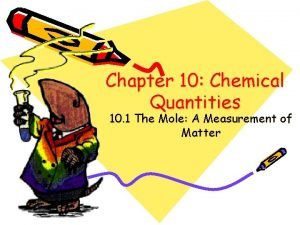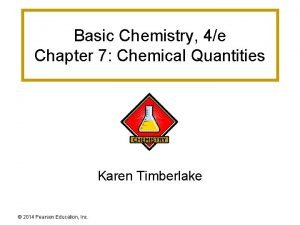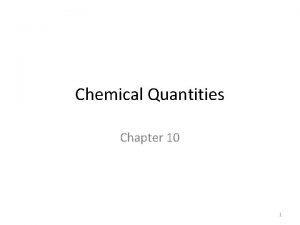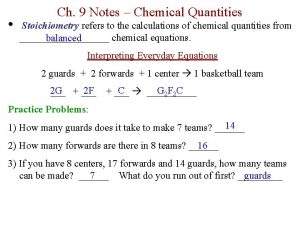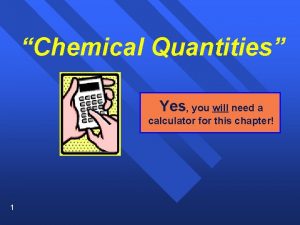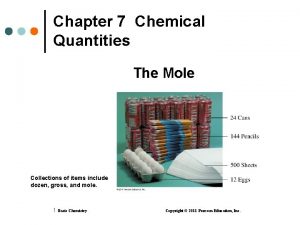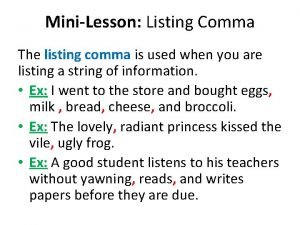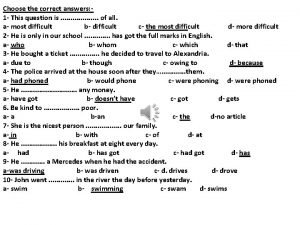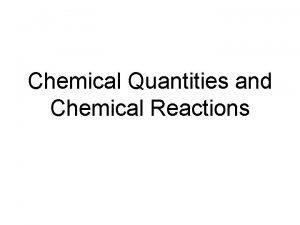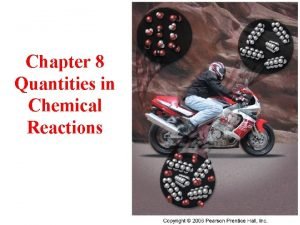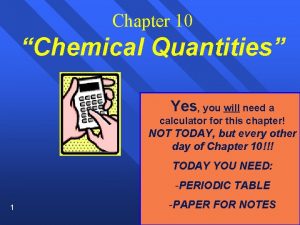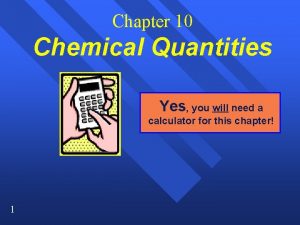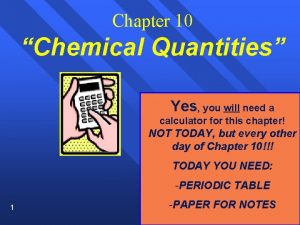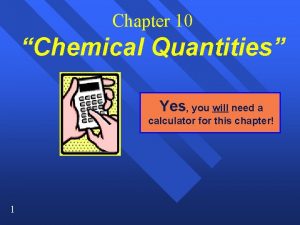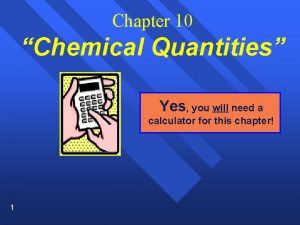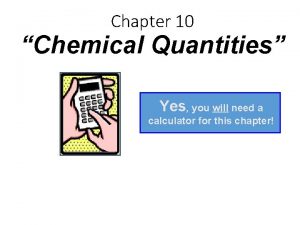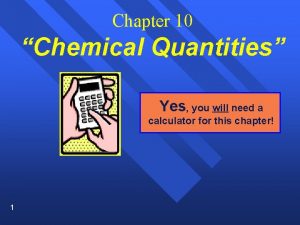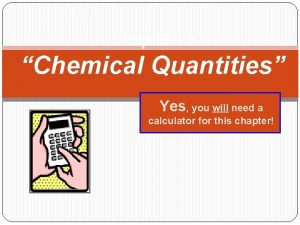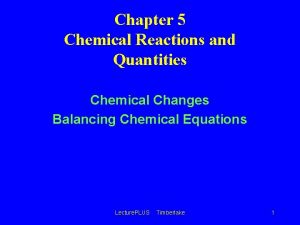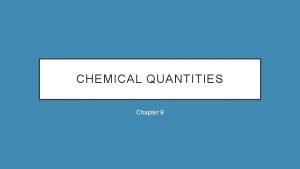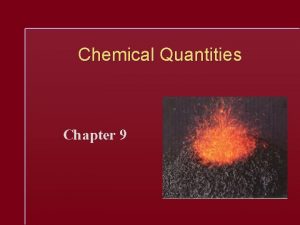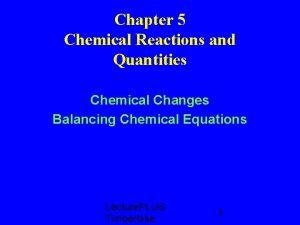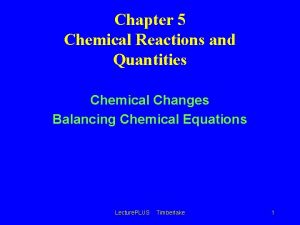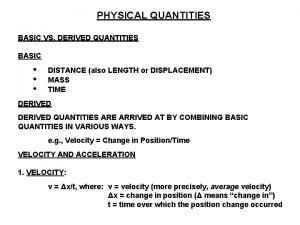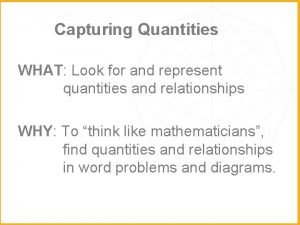Chapter 10 Chemical Quantities You will need a









































- Slides: 41

Chapter 10 “Chemical Quantities” You will need a calculator for this chapter!

The Mole: A Measurement of Matter

How do we measure items? § You can measure the amount of something by mass, by volume, and by count. § We measure mass in grams § We measure volume in liters § We count pieces in MOLES

Other Ways to Measure Amount § § Pair: 1 pair of socks = 2 socks Dozen: 1 dozen donuts = 12 donuts Gross: 1 gross of pencils = 144 pencils (12 dozen) Ream: 1 ream of paper = 500 sheets of paper

Practice Problem #2 • Assume 2. 0 kg of apples is 1 dozen and that each apple has 8 seeds. How many apple seeds are in 14 kg of apples? (work INDEPENDENTLY to solve)

What is the mole? Not this kind of mole!

Moles (abbreviated mol) § Derived from German word molekül (molecule) § SI measurement of an amount § 1 mole = 6. 02 x 1023 of representative particles, or…. . § # of carbon atoms in exactly 12 g of Carbon-12 isotope § Called Avogadro’s number

What are Representative Particles? § The smallest pieces of a substance: 1) molecular cmpd - molecule 2) ionic cmpd - formula unit (made of ions) 3) element: is the atom • Remember the 7 diatomic elements? (made of molecules) Br. INCl. HOF Br 2 I 2 N 2 Cl 2 H 2 O 2 F 2

Consider these questions: • How many oxygen atoms in the following? Ca. CO 3 3 atoms of oxygen Al 2(SO 4)3 12 (3 x 4) atoms of oxygen • How many ions in the following? Ca. Cl 2 3 total ions (1 Ca ion and 2 Cl ions) Na. OH 2 total ions (1 Na ion and 1 OH ion) Al 2(SO 4)3 2+ 1+ 1 - 1 - 5 total ions (2 Al 3+ + 3 SO 42 - ions)

The Mass of a Mole of an Element § Atomic mass of element (mass of 1 atom) expressed in amu - atomic masses - relative masses based on mass of C-12 (12. 0 amu) - 1 amu is 1/12 mass of C-12 atom

Molar Mass…. § = mass of 1 mol of element in grams (periodic table) § 12. 01 grams C has same # particles as 1. 01 g H & 55. 85 g Fe § 12. 01 g C = 1 mol C All contain § 1. 01 g H = 1 mol H 6. 02 x 1023 § 55. 85 g Fe = 1 mol Fe atoms

What about compounds? § 1 mol of H 2 O molecules has 2 mol of H atoms & 1 mol of O atoms (think of a compound as a molar ratio) § To find mass of 1 mol of a cmpd: odetermine # moles of elements present o. Multiply # times their mass (from periodic table) oadd up for total mass

Calculating Molar Mass Calculate molar mass of magnesium carbonate, Mg. CO 3. 24. 3 g + 12. 0 g + 3 x (16. 00 g) = 84. 3 g So, 84. 3 g = molar mass for Mg. CO 3

Mole-Mass and Mole. Volume Relationships

Molar Mass § Molar mass - generic term for mass of 1 mol of any substance (expressed in grams/mol) § Same as: 1) Gram Molecular Mass (for molecules) 2) Gram Formula Mass (ionic compounds) 3) Gram Atomic Mass (for elements) o molar mass is more broad term than these other specific masses

Examples § Calculate the molar mass of: = 78. 05 g/mol Na 2 S N 2 O 4 = 92. 02 g/mol C = 12. 01 g/mol Ca(NO 3)2 = 164. 10 g/mol C 6 H 12 O 6 = 180. 12 g/mol (NH 4)3 PO 4 = 149. 12 g/mol

Molar Mass is… § # of g in 1 mol of atoms, formula units, or molecules § Make conversion factors from these - To change btwn g of cmpd and mol of cmpd

Using the Mole Roadmap § How many moles is 5. 69 g of 0. 142 mol Na. OH?

The Mole-Volume Relationship §gases - hard to determine mass § how many moles of gas? § 2 things affect gas V: § a) Temp & b) Pressure § compare all gases at = temp & pressure

Standard Temperature and Pressure § 0ºC & 1 atm pressure - abbreviated “STP” § At STP, 1 mol of any gas has V of 22. 4 L - Called molar volume § 1 mol of any gas at STP = 22. 4 L

Mole Day Celebrated on October 23 rd from 6: 02 am until 6: 02 pm (6: 02 on 10 -23)

Density of a gas § D = m / V (density = mass/volume) - for gas units are: g / L § find density of a gas at STP if formula known § You need: 1) mass and 2) volume § Assume 1 mol, so mass is molar mass (from periodic table) § At STP, V = 22. 4 L

Practice Examples (D=m/V)

Another way: § If given density, density find molar mass of gas § Assume 1 mol at STP, so V = 22. 4 L m=Dx. V modify: D = m/V to show: § “m” will be mass of 1 mol, given 22. 4 L § What is molar mass of a gas with density = 44. 0 g/mol of 1. 964 g/L? § How about a density of 2. 86 g/L? 64. 0 g/mol

Summary • all equal: a) 1 mole b) molar mass (in grams/mol) c) 6. 02 x 1023 representative particles (atoms, molecules, or formula units) d) 22. 4 L of gas at STP make conversion factors from these 4 values (p. 303)

Notice all conversions must go through the MOLE!

Percent Composition and Chemical Formulas

§ All percent problems: part x 100 % = percent whole 1) Find mass of each element, 2) Divide by total mass of cmpd; & x 100 %mass of element = mass of element mass of cmpd x 100%

% composition from mass § Calculate the percent composition of a compound that is made of 29. 0 grams of Ag with 4. 30 grams of S. 29. 0 g Ag X 100 = 87. 1 % Ag 33. 3 g total 4. 30 g S X 100 = 12. 9 % S 33. 3 g total Total = 100 %

% comp from the chemical formula § If we know formula, assume you have 1 mole, § Subscripts used to calculate mass of each element in 1 mole of cmpd § sum of masses is molar mass Mass of element in 1 mol cmpd x 100% %mass = Molar mass of cmpd

% Composition Examples

% composition as conversion factor § We can also use % as conversion factor to calculate # grams of element in cmpd § Calculate % C in C 3 H 8 § What is mass of C in 82. 0 g sample of propane (C 3 H 8) 67. 1 g C

Calculating Empirical § Find lowest whole number ratio C 6 H 12 O 6 = CH 2 O CH 4 N = this is already the lowest ratio. § A formula is not just ratio of atoms, atoms it is also ratio of moles § 1 molecule of CO 2 = 1 atom of C and 2 atoms of O § 1 mol of CO 2 = 1 mol C and 2 mol O

Calculating Empirical § get a ratio from % composition 1) Assume you have a 100 g sample - the percentage become grams (75. 1% = 75. 1 grams) grams 2) Convert grams to moles 3) Find lowest whole number ratio by dividing each # of moles by smallest value

Example § Calculate empirical formula of cmpd composed of 38. 67 % C, 16. 22 % H, and 45. 11 %N. CH 5 N § Assume 100 g sample, so § 38. 67 g C x § 16. 22 g H x § 45. 11 g N x 1 mol C = 3. 22 mole C 12. 0 g C 1 mol H = 16. 22 mole H 1. 0 g H 1 mol N = 3. 22 mole N 14. 0 g N Now divide each value by the smallest value

Example § The ratio is 3. 22 mol C = 1 mol C 3. 22 mol N 1 mol N § The ratio is 16. 22 mol H = 5 mol H 3. 22 mol N 1 mol N = C 1 H 5 N 1 which is = CH 5 N

Practice Problem Calculate the empirical formula of: 94. 1% O, 5. 9% H

What is a Molecular Formula? • Molecular formula: true # of atoms of each element in formula of cmpd • molecular cmpds only • Example: molecular formula for benzene is C 6 H 6 (note that everything is divisible by 6) • Therefore, empirical formula = lowest whole number ratio) CH (the

Formulas (continued) ionic compounds ALWAYS empirical (cannot be reduced). Examples: Na. Cl Mg. Cl 2 Al 2(SO 4)3 K 2 CO 3

Formulas (continued) Formulas for molecular compounds MIGHT be empirical (lowest whole number ratio). Molecular: (Correct formula) Empirical: (Lowest whole number ratio) H 2 O C 6 H 12 O 6 C 12 H 22 O 11 H 2 O CH 2 O C 12 H 22 O 11

Empirical to molecular § Since empirical formula is lowest ratio, the actual molecule weighs more Molar mass = Empirical formula mass whole # to increase each coefficient in empirical formula
 Angular acceleration vs linear acceleration
Angular acceleration vs linear acceleration Chapter 7 chemical quantities answer key
Chapter 7 chemical quantities answer key Chemistry chapter 10 chemical quantities
Chemistry chapter 10 chemical quantities Chapter 7 chemical quantities answer key
Chapter 7 chemical quantities answer key Chemical quantities chapter 10
Chemical quantities chapter 10 Chapter 10 chemical quantities practice problems answer key
Chapter 10 chemical quantities practice problems answer key Chapter 9 chemical quantities
Chapter 9 chemical quantities The calculation of quantities in chemical reactions
The calculation of quantities in chemical reactions The calculation of quantities in chemical equations
The calculation of quantities in chemical equations Chemical quantities calculator
Chemical quantities calculator Unit chemical quantities the mole 1 step
Unit chemical quantities the mole 1 step We wish you strength
We wish you strength Punctuating split speech
Punctuating split speech Chapter 7 review chemical formulas and chemical compounds
Chapter 7 review chemical formulas and chemical compounds 7-3 practice problems chemistry answers
7-3 practice problems chemistry answers Are kc and kp equal
Are kc and kp equal Physical quantities units and measurement
Physical quantities units and measurement Section 2 reinforcement classifying chemical reactions
Section 2 reinforcement classifying chemical reactions Section 2 reinforcement classifying chemical reactions
Section 2 reinforcement classifying chemical reactions Chemical reactions section 1 chemical changes
Chemical reactions section 1 chemical changes Chapter 10 chemical reactions answer key
Chapter 10 chemical reactions answer key Chapter 9 chemical reactions study guide
Chapter 9 chemical reactions study guide Tetraphosphorus octoxide formula
Tetraphosphorus octoxide formula It can be quite busy here during the tourist
It can be quite busy here during the tourist 5 hobbies you need
5 hobbies you need You only need to be lucky once
You only need to be lucky once I need attention
I need attention Example of why oxford comma is important
Example of why oxford comma is important Edna st vincent millay love is not all
Edna st vincent millay love is not all Coherence examples
Coherence examples How to properly quote in an essay
How to properly quote in an essay Do you have to sign your passport
Do you have to sign your passport Genre of an essay
Genre of an essay Everything you need to know about the odyssey
Everything you need to know about the odyssey Useful high friction
Useful high friction What are five reasons expressways have fewer collisions
What are five reasons expressways have fewer collisions Choose the correct answers look that boy's
Choose the correct answers look that boy's Let's be a good friend
Let's be a good friend You need to make at least 150 sandwiches for a picnic
You need to make at least 150 sandwiches for a picnic Much do you need health
Much do you need health Hebrews 10:36 sermon
Hebrews 10:36 sermon I need you lord jesus
I need you lord jesus


